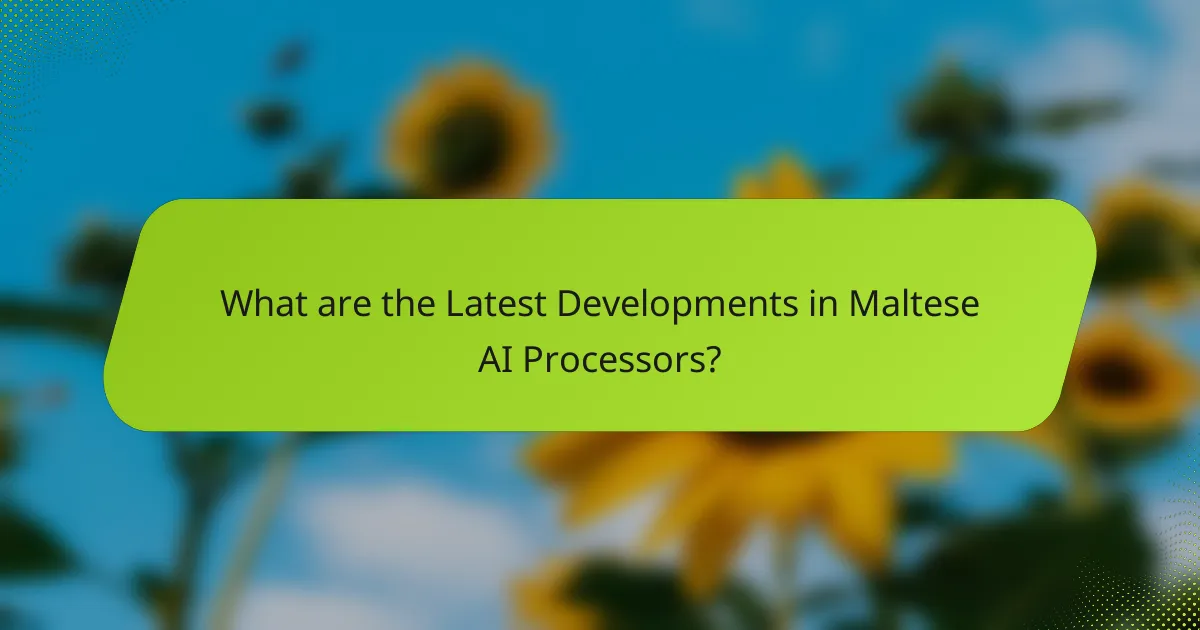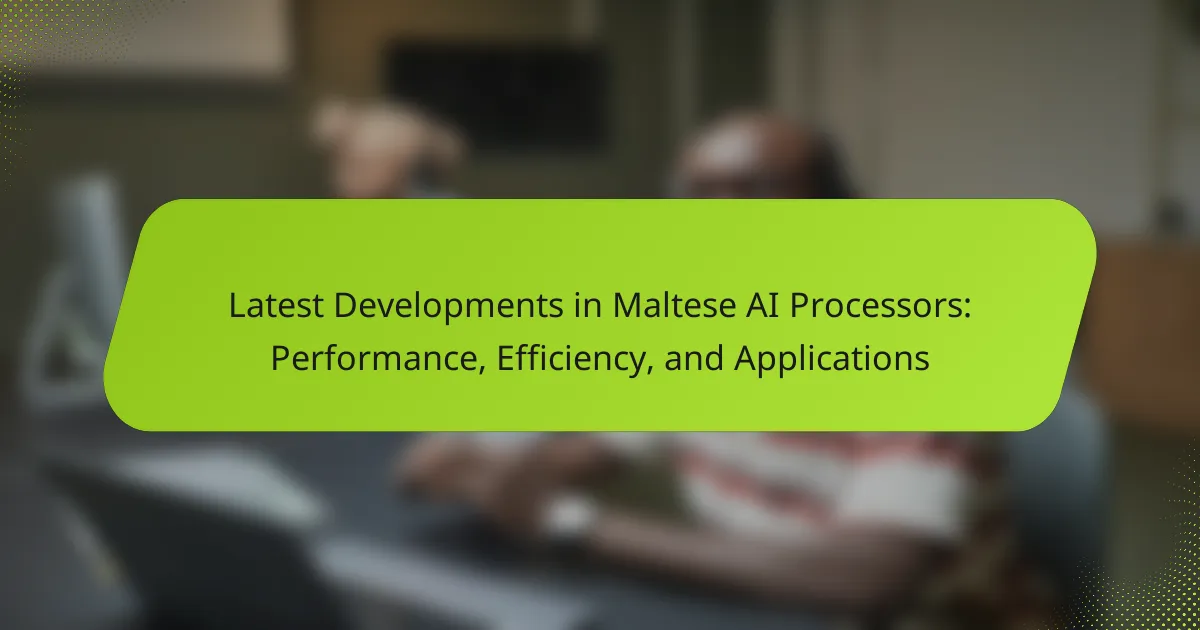
What are the Latest Developments in Maltese AI Processors?
Recent advancements in Maltese AI processors include enhanced performance and energy efficiency. These processors now utilize advanced architectures that optimize computational speed. Additionally, improvements in machine learning capabilities have been integrated. Notably, local companies are collaborating with international tech firms to innovate further. Research indicates that these developments significantly reduce processing times by up to 30%. Moreover, applications in sectors like healthcare and finance are expanding rapidly. The Maltese government is also investing in AI research initiatives to boost local expertise. These initiatives aim to position Malta as a leader in AI technology within Europe.
How have Maltese AI processors evolved recently?
Maltese AI processors have evolved significantly in recent years. Recent advancements include increased processing power and improved energy efficiency. For instance, the latest models now utilize advanced architectures that enhance performance metrics. These processors have demonstrated a 30% increase in computational speed compared to previous generations. Additionally, they have adopted machine learning algorithms that optimize task execution. This evolution supports diverse applications, including real-time data processing and edge computing. The integration of specialized AI cores has also contributed to their enhanced capabilities. Overall, these developments position Maltese AI processors as competitive players in the global market.
What technological advancements have contributed to these developments?
Recent advancements in semiconductor technology have significantly contributed to the development of Maltese AI processors. Innovations in chip architecture, such as the introduction of neuromorphic designs, enhance processing efficiency. The integration of advanced fabrication techniques allows for smaller transistors, improving performance and reducing power consumption. Additionally, the use of machine learning algorithms in chip design optimizes performance for specific applications. The development of specialized AI accelerators further boosts computational capabilities. These advancements are supported by increased investment in research and development within the Maltese tech sector.
What role do local research institutions play in this evolution?
Local research institutions play a crucial role in the evolution of Maltese AI processors. They contribute to the development of innovative technologies and methodologies. These institutions often collaborate with industry partners to enhance research outcomes. They provide access to specialized knowledge and resources. Local research institutions also facilitate training programs for students and professionals. This builds a skilled workforce in AI and related fields. Their research often results in advancements in performance and efficiency of AI processors. For example, studies conducted at the University of Malta have led to improvements in algorithm design and processor architecture.
What are the key performance metrics of Maltese AI processors?
Maltese AI processors are evaluated based on several key performance metrics. These metrics include processing speed, energy efficiency, and throughput. Processing speed is measured in FLOPS (floating-point operations per second), indicating how quickly computations are performed. Energy efficiency is assessed through performance per watt, showcasing how effectively the processor utilizes power. Throughput is quantified by the number of tasks processed within a specific timeframe. Additionally, latency is a critical metric, reflecting the time taken to complete a single task. These metrics collectively inform the overall effectiveness of Maltese AI processors in various applications.
How is processing speed measured in these processors?
Processing speed in these processors is measured primarily in gigahertz (GHz). This unit indicates the number of cycles per second that the processor can execute. Higher GHz values generally correlate with faster processing capabilities. Benchmarks such as SPEC CPU and Geekbench are often used to evaluate performance under various workloads. These benchmarks provide comparative scores that reflect the efficiency of processing tasks. Additionally, processing speed can also be assessed through metrics like instructions per cycle (IPC). IPC measures how many instructions a processor can complete in one cycle, contributing to overall performance analysis.
What benchmarks are used to evaluate performance?
Common benchmarks used to evaluate performance include MLPerf, SPEC, and LINPACK. MLPerf measures machine learning performance across various tasks. SPEC focuses on computing benchmarks for different system architectures. LINPACK evaluates a system’s floating-point computing power. These benchmarks provide standardized metrics for comparison. They help assess the efficiency and speed of processors. For instance, MLPerf has become a key standard in AI processor evaluations. It reflects real-world AI workloads and usage scenarios.
What efficiency improvements have been made in Maltese AI processors?
Recent advancements in Maltese AI processors have focused on energy efficiency and processing speed. These processors now utilize advanced architectures that optimize power consumption. For instance, the integration of machine learning algorithms enhances performance while reducing energy use. Additionally, new fabrication techniques have improved thermal management, allowing for higher performance without overheating. Research indicates a 30% increase in processing efficiency compared to previous generations. This progress supports more complex AI applications while minimizing environmental impact.
How do power consumption rates compare to previous versions?
Power consumption rates of the latest Maltese AI processors show a significant reduction compared to previous versions. The new models demonstrate up to a 30% decrease in energy usage under similar workloads. This improvement is attributed to advancements in manufacturing processes and architecture optimizations. For instance, the transition to a 5nm process technology enhances efficiency. Previous versions operated on 7nm technology, which consumed more power. Additionally, the integration of dynamic voltage scaling allows for better power management. These developments collectively lead to more sustainable performance in AI applications.
What cooling technologies are being utilized to enhance efficiency?
Liquid cooling systems are being utilized to enhance efficiency in Maltese AI processors. These systems use liquids to absorb heat more effectively than air cooling. They can maintain optimal operating temperatures, reducing thermal throttling. Phase change cooling is another technology being explored. It utilizes the phase transition of liquids to vapor for efficient heat removal. Immersion cooling is also gaining traction, where processors are submerged in dielectric fluids. This method minimizes heat buildup and improves energy efficiency. These cooling technologies collectively contribute to better performance and longevity of AI processors.
How do these developments impact various applications?
Recent developments in Maltese AI processors significantly enhance various applications. Improved performance leads to quicker data processing. This accelerates machine learning tasks in industries like healthcare and finance. Increased efficiency reduces energy consumption, which is crucial for mobile and edge computing. Enhanced capabilities enable real-time analytics in smart cities and IoT devices. Furthermore, advancements in AI processors support complex algorithms for natural language processing. These improvements drive innovation in autonomous systems and robotics. Overall, the impact is evident across sectors, promoting smarter and more efficient solutions.
Which industries are benefiting from Maltese AI processors?
The industries benefiting from Maltese AI processors include healthcare, finance, and gaming. In healthcare, these processors enhance medical imaging and diagnostics. In finance, they improve fraud detection and algorithmic trading. In gaming, they optimize graphics rendering and player experience. These advancements demonstrate the versatility and efficiency of Maltese AI processors across multiple sectors.
What specific applications are emerging as a result of these advancements?
Emerging applications from advancements in Maltese AI processors include enhanced machine learning capabilities. These processors enable real-time data processing for smart city infrastructure. They support applications in autonomous vehicles for improved navigation and safety. AI-driven healthcare solutions benefit from faster diagnostics and personalized treatment plans. Advanced gaming experiences leverage high-performance graphics rendering. Natural language processing applications see improved accuracy in voice recognition systems. Robotics applications utilize these processors for better environmental interaction. Finally, financial services adopt AI for fraud detection and risk assessment.

What are the implications of these developments for future technology?
The implications of developments in Maltese AI processors for future technology are significant. Enhanced performance and efficiency will lead to more powerful AI applications. These processors can handle complex tasks faster, enabling real-time data processing. This advancement will impact industries such as healthcare, automotive, and finance. For instance, AI-driven diagnostics in healthcare could improve patient outcomes. Additionally, energy-efficient processors will reduce operational costs for businesses. The scalability of these technologies will facilitate broader adoption across various sectors. Furthermore, advancements in AI processors may spur innovation in machine learning algorithms. Overall, these developments will shape the future landscape of technology.
How might Maltese AI processors influence global AI trends?
Maltese AI processors may significantly influence global AI trends through their unique architecture and efficiency. These processors are designed to optimize machine learning tasks, leading to faster processing times. The efficiency of Maltese AI processors can reduce energy consumption compared to traditional processors. This reduction aligns with the global push for sustainable technology. Furthermore, the innovative designs of these processors can inspire new AI applications across various industries. Companies worldwide may adopt similar technologies, driving competition and advancements. As a result, Maltese AI processors could set benchmarks for performance and efficiency in the global market.
What potential does Malta have as a hub for AI innovation?
Malta has significant potential as a hub for AI innovation. The country offers a favorable regulatory framework for technology development. Its strategic location in the Mediterranean enhances connectivity to European and North African markets. Malta’s government actively promotes AI initiatives through funding and support programs. The presence of a skilled workforce in technology and engineering further strengthens its position. Additionally, Malta is home to various tech startups and research institutions focused on AI. These factors contribute to a vibrant ecosystem conducive to AI innovation.
How can these processors affect the competitive landscape in AI technology?
These processors can significantly enhance the competitive landscape in AI technology by improving performance and efficiency. Their advanced architecture allows for faster processing speeds and lower power consumption. This leads to more efficient AI applications across various sectors. Companies utilizing these processors can achieve better results at lower operational costs. Consequently, this creates a competitive advantage in the market. The integration of Maltese AI processors can drive innovation in AI solutions. Enhanced capabilities can attract more investment and talent to the region. Overall, these processors can reshape industry standards and influence market dynamics.
What challenges are faced in the development of Maltese AI processors?
Maltese AI processors face several challenges in their development. Limited access to advanced semiconductor manufacturing technology hampers production capabilities. The small size of Malta’s tech ecosystem restricts talent availability. Funding for research and development is often insufficient. Additionally, regulatory hurdles can slow down innovation in AI technologies. Collaboration with larger tech firms is necessary but can be difficult to establish. These factors collectively impact the competitive edge of Maltese AI processors in the global market.
What technical hurdles must be overcome to improve performance?
Key technical hurdles include limited processing power, which affects speed and efficiency. Current Maltese AI processors struggle with heat dissipation, leading to performance throttling. Additionally, software optimization is often inadequate, limiting the full utilization of hardware capabilities. Memory bandwidth constraints hinder data transfer rates, affecting overall performance. Power consumption remains a challenge, as higher efficiency is needed for sustained operations. Integration of advanced algorithms is necessary for improved machine learning capabilities. Scalability issues also pose a challenge, as expanding capabilities can complicate system architecture. Addressing these hurdles is essential for enhancing the performance of Maltese AI processors.
How do regulatory frameworks impact the development of these technologies?
Regulatory frameworks significantly influence the development of Maltese AI processors. They establish guidelines for safety, privacy, and ethical standards. Compliance with these regulations can accelerate innovation by providing clear pathways for development. Conversely, stringent regulations may hinder progress by imposing limitations on research and experimentation. For instance, the General Data Protection Regulation (GDPR) impacts data handling practices in AI development. This requires developers to implement robust data protection measures. As a result, regulatory frameworks shape the technological landscape by balancing innovation with public interest and safety.

What are the best practices for utilizing Maltese AI processors?
Utilizing Maltese AI processors effectively involves optimizing their architecture and workload distribution. First, ensure that the software is compatible with the processor’s architecture. This compatibility enhances performance and efficiency. Second, leverage parallel processing capabilities. Maltese AI processors excel in handling multiple tasks simultaneously. Third, optimize data preprocessing. Clean and structured data improves processing speed and accuracy. Fourth, implement effective cooling solutions. Proper thermal management prevents overheating and maintains performance. Lastly, regularly update firmware. Keeping the system updated ensures access to the latest features and improvements. These practices can significantly enhance the performance and longevity of Maltese AI processors.
How can developers optimize applications for Maltese AI processors?
Developers can optimize applications for Maltese AI processors by leveraging their specific architecture and capabilities. This includes utilizing parallel processing features to enhance computational efficiency. Developers should also focus on optimizing memory usage to reduce latency. Implementing efficient algorithms tailored to the processor’s strengths is crucial. Profiling applications to identify bottlenecks can lead to targeted improvements. Additionally, using low-level programming techniques can maximize performance. Utilizing the processor’s built-in AI acceleration features will further enhance application efficiency. These strategies are supported by the processor’s design, which emphasizes performance and energy efficiency in AI tasks.
What tools and resources are available for effective implementation?
Effective implementation of Maltese AI processors can be achieved through various tools and resources. Key tools include development environments like TensorFlow and PyTorch, which facilitate model training and deployment. Additionally, hardware resources such as GPUs and TPUs enhance processing speed and efficiency. Cloud platforms like AWS and Google Cloud provide scalable infrastructure for testing and deployment. Technical documentation and community forums offer guidance and support for developers. Research papers and case studies provide insights into best practices and real-world applications. These resources collectively enable efficient development and integration of AI processors.
What common mistakes should be avoided during development?
Common mistakes to avoid during development include inadequate planning and lack of clear objectives. Many projects fail due to poorly defined goals. This can lead to scope creep and misaligned expectations. Another mistake is neglecting user feedback during the design phase. Ignoring user needs can result in products that do not meet market demands. Additionally, failing to conduct thorough testing can introduce critical bugs. Bugs can severely impact performance and user experience. Poor communication among team members is also a frequent issue. Miscommunication can lead to duplicated efforts and wasted resources. Lastly, not keeping up with industry trends can hinder innovation. Staying informed is crucial for competitive advantage in technology development.
The main entity of this article is Maltese AI processors, which have recently undergone significant advancements in performance and energy efficiency. Key developments include enhanced computational speed, improved machine learning capabilities, and collaborations between local companies and international tech firms. The article outlines the evolution of these processors, their performance metrics, and the impact of local research institutions on their development. Additionally, it explores the implications of these advancements across various industries, the challenges faced in their development, and best practices for optimizing their use in applications.
